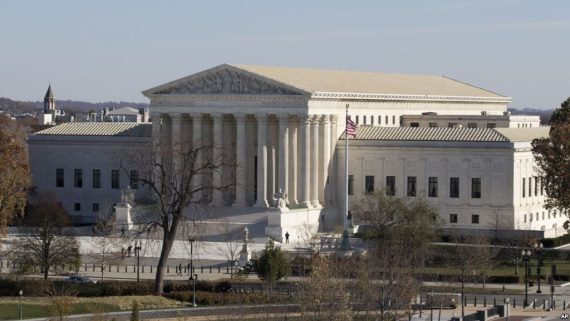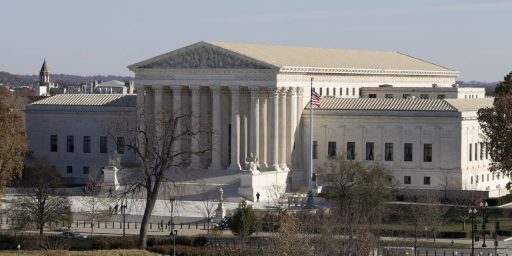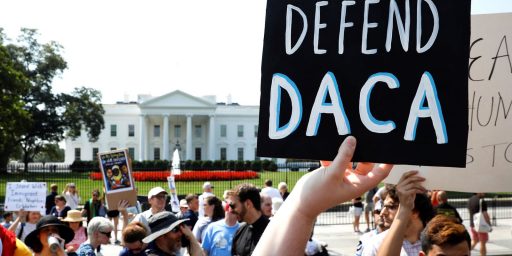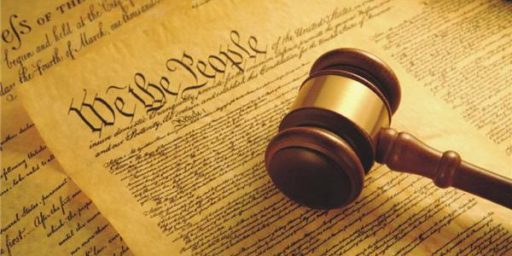Supreme Court Accepts Appeal Of Ruling Halting Obama’s Deportation Relief Programs
The Supreme Court agreed to hear an appeal in what is guaranteed to be a high profile case heading into the 2016 elections.
The Supreme Court will hear the Obama Administration’s appeal of a lower court decision halting the temporary deportation relief that President Obama adopted via execution action more than a year ago and issue a decision before the end of its term in June, thus adding to the list of Supreme Court cases likely to become an issue in this year’s Presidential election:
WASHINGTON — The Supreme Court said Tuesday that it would consider a legal challenge to President Obama’s overhaul of the nation’s immigration rules. The court, which has twice rejected challenges to Mr. Obama’s health care law, will now determine the fate of one of his most far-reaching executive actions.
Fourteen months ago, Mr. Obama ordered the creation of a program intended to allow as many as five million illegal immigrants who are the parents of citizens or of lawful permanent residents to apply for a program sparing them from deportation and providing them work permits. The program was called Deferred Action for Parents of Americans and Lawful Permanent Residents, or DAPA.
The president has said the program was the result of years of frustration with Republicans in Congress who had repeatedly refused to support bipartisan Senate legislation to update immigration laws. In an Oval Office address just before Thanksgiving in 2014, Mr. Obama excoriated Republicans for refusing to cooperate and told millions of illegal immigrants, “You can come out of the shadows.”
But the president’s promise has gone unfulfilled. A coalition of 26 states, led by the attorney general in Texas, a Republican, quickly filed a lawsuit accusing the president of ignoring federal procedures for changing rules and of abusing the power of his office by sidestepping Congress.
In February, Judge Andrew S. Hanen of Federal District Court in Brownsville, Tex., entered a preliminary injunction shutting down the program while the legal case proceeded. The government appealed, and on Nov. 9 a divided three-judge panel of the United States Court of Appeals for the Fifth Circuit, in New Orleans, affirmed the injunction.
If the Supreme Court upholds Mr. Obama’s actions, the White House has vowed to move quickly to set up the DAPA program and begin enrolling immigrants before his successor takes over early next year. Democratic presidential candidates have said they will continue the program, but most of the Republicans in the race have vowed to dismantle it and redouble immigration enforcement.
The administration, fearing that the program could remain frozen through the balance of Mr. Obama’s presidency, had asked the court to move quickly. On that point, at least, the court agreed, and it now appears that the case will be argued in April and decided by the end of June.
As is their custom, the justices gave no reasons for agreeing to hear the case, United States v. Texas, No. 15-674.
The court did broaden the scope of the case, asking the parties to address an additional and fundamental question: whether the administration’s plan violates the constitutional command that the president “shall take care that the laws be faithfully executed.”
(…)
In their written arguments before the court, the states acknowledged that the president has wide authority over immigration matters, telling the justices that “the executive does have enforcement discretion to forbear from removing aliens on an individual basis.” Their quarrel, they said, was with what they called a blanket grant of “lawful presence” to millions of immigrants, entitling them to various benefits.
In response, Solicitor General Donald B. Verrilli Jr. told the justices that “lawful presence” is merely what has always followed from the executive branch’s decision not to deport someone for a given period of time.
He added that the consequences of allowing immigrants to be lawfully present were positive. “Without work authorization,” Mr. Verrilli wrote of the people eligible for the program, “they are more likely to work for employers who will hire them illegally, often at below-market wages, thereby hurting American workers and giving unscrupulous employers an unfair advantage.”
Much of the briefing so far has been focused on the threshold question of whether the states have suffered the sort of direct and concrete injury that gives them standing to sue. The question will play a major role as the Supreme Court considers the case.
Judge Jerry E. Smith, writing for the majority in the appeals court, said the states had standing to challenge the program under a 2007 Supreme Court decision that said Massachusetts and other states were entitled to sue the Environmental Protection Agency over its refusal to regulate motor vehicle emissions contributing to climate change.
Judge Smith said Texas would suffer a similarly direct and concrete injury in having to spend millions of dollars to provide driver’s licenses to immigrants as a consequence of the federal program.
Mr. Verrilli told the justices that Texas’ injury, such as it was, was self-inflicted, a product of its own decision to offer driver’s licenses to people lawfully in the United States at reduced cost.
Texas responded that being required to change its laws is itself the sort of harm that confers standing. “Texas could avoid the driver’s-license-cost injury only by changing its policy and making driver’s licenses less affordable,” the states told the justices. “That is itself an injury, because Texas has a sovereign interest in enforcing its legal code.”
Lyle Denniston discusses the Court’s decision, including the fact that it has added another question for the parties to address in addition to the issues that the Obama Administration raised in its appeal:
The immigration case involves a policy that could postpone, for three years and perhaps longer, the deportation of more than four million individuals who entered the country illegally. The policy mainly involves parents of children who are U.S. citizens or have permanent resident alien status. Announced fourteen months ago, the parents policy has never gone into effect because it is blocked by lower court orders in a case filed by twenty-six states.
A rather unusual aspect of the case was that, although the lower courts had not decided a constitutional question the states had raised, the Justices added that question on their own. It is whether the policy violates the constitutional clause that requires the president to “take care” that the laws passed by Congress are faithfully executed.
It is rare for the Court to take up an issue that was left undecided in lower courts. The question no doubt was added to assure that all aspects of the states’ challenge are reviewed together.
In addition to that issue, the case involves whether the states had a legal right to sue, or are barred from doing so under Article III; whether the policy is “arbitrary” and beyond the president’s powers under federal immigration laws, and whether it is illegal because the government did not seek public reaction to it before adopting it as policy.
The government got what it wanted with the Court’s agreement to set it for argument during the current Term, but did not get what it wanted on the scope of the Court’s review. Its appeal had raised the “standing” and statutory issues. The states, in replying to the appeal, urged the Court to add the “Take Care Clause” issue. The states believe that the policy contradicts existing laws on deportation, and amounted to the president acting as if he had legislative power. The government opposed expanding the case to include that issue — which, it argued, added nothing to the states’ statutory arguments.
Before the Court gets to the other questions in the case, it will have to make up its mind on the Article III issue: did the states have a right to sue the president over the way he chose to enforce immigration laws? To get over that barrier, the states must convince the Court that at least one of them will suffer a legal injury if the policy goes into effect. Lower courts ruled that Texas would be injured because of the cost of providing driver’s licenses for those individuals allowed to stay in the country.
If the Court were to find that the states were barred from suing, that would be the end of the case. If the states prevail on that question, the legal fate of the policy would then be up to the Court. Although the case has not yet gone to a trial, it appeared that the Court was prepared to settle the validity of the program without waiting for further activity in lower courts, if it is satisfied that the states had a right to sue.
It’s not entirely surprising that the Supreme Court decided to accept this case given the fact that it involves both a direct challenge to an important Federal policy, but also a Court ruling holding that policy unconstitutional and a direct conflict between the states and the Federal Government. On some level, these are precisely the types of cases that the Supreme Court was created to resolve in the first place. Additionally, the fact that the lower courts in this matter have found that the states do in fact have standing to bring this kind of lawsuit against the Federal Government, something that is definitely an expansion of traditional conceptions of standing in Federal Courts, It is somewhat unusual for the Court to add questions to those that would be considered on appeal, especially one that seems to go beyond the issues that were considered in the case being appealed itself. As the case stands, the only issues that have been definitively decided by the courts below deal with the states request for a temporary injunction on the enforcement of the President’s orders granting temporary deportation relief and the issue of whether or not the states have the right to bring this suit in the first place. Just under a year ago, a District Court Judge found that the states did have standing to sue in this case and that a temporary injunction was appropriate, but the primary basis for the injunction was the state’s statutory claim that the Administration had not complied with a law called the Administrative Procedures Act that requires a public notice and comment period when certain changes are made to Federal regulations. The Court did address the state’s Constitutional issues in a cursory manner, but since it had found that there was a likelihood they would succeed on their APA claims there was no need for him to address the Constitutional issues in detail until later in the process. In both a preliminary ruling last May and a final ruling in November, the Fifth Circuit Court of Appeals upheld the District Court’s rulings on both the standing issue and the Administrative Procedure Act issue. Now, the Supreme Court will hear the case in a manner that potentially allows it to address not just these issues, but also, potentially, the ultimate issue in the case, something which could potentially resolve the entire case in one fell swoop by the end of June this year. Alternatively, the Court could bring the entire case to a quick end by ruling that the states do not have standing to bring suits of this type at all. In that case, everything that has happened in the courts below would effectively be moot and the case would have to be dismissed.
As of now, we don’t know when the Court is likely to hear this case, but given the fact that the argument calendar is largely already full for the rest of the year, it is likely to be some time during the final weeks the Justices will be sitting for oral argument in April. No doubt, these arguments, along with the ultimate decision, will be closely watched by all sides in the immigration policy debate. Additionally, this case joins a list of significant cases that the Supreme Court will rule on between now and June that are likely to have an impact on the Presidential election as well as down ballot races such as the closely watched races for the United States Senate that could decide which party controls that body after December. This includes cases dealing with issues ranging from Affirmative Action, to abortion, reapportionment, to yet another case about religious liberty and the PPACA’s contraceptive mandate. Each of these cases raises issues that are likely to be a hot button issue in the Presidential election, especially given the fact that, with four Supreme Court Justices currently at the age of 75 or older, it is quite likely that the next President will likely get to nominate, and the next Senate will have to confirm, at least one Supreme Court Justice in the first term of the next President, and probably more than one during that time period. Now, the Justices have added immigration policy as well as the issues regarding the expansion of Executive Branch power that Republicans have latched onto during the Obama Administration and, as Greg Sargent puts it, that’s likely to set off a bomb in the middle of the 2016 Presidential race:
No matter what the Court decides in June, it will probably set off a bomb in the middle of the presidential election. Here’s why: If the Court allows DAPA to proceed, it will probably enrage the right and increase pressure on the GOP nominee — or the GOP candidates if there isn’t a nominee by then — to promise to reverse DAPA as president. Thus the GOP nominee may well end up redoubling his commitment to revoking the protection from deportation enjoyed by millions of immigrants. Alternatively, if DAPA is struck down, it will reignite the debate over what should be done about the millions of undocumented immigrants in this country. That could serve as a reminder that the GOP positions on this question range from proactive mass deportation (Donald Trump) to leaving them in the shadows and deporting them as the occasion arises (Ted Cruz) to maybe legalizing them at some undetermined point in the future once some undefined state of border security perfection is attained (Marco Rubio). And Republicans will be cheering the legal defeat of Obama’s efforts to shield millions from deportations.
Obviously Republicans might argue that this is a good debate for them — that swing voters don’t like Obama’s executive actions on behalf of immigrants and that it energizes the GOP base. Even if that is right, however, what will probably matter most for 2016 is how this battle colors the views of the two parties arrived upon by Latino voters. (Indeed, some GOP strategists clearly agree that this is the case, given their efforts to get the GOP to moderate on immigration.) And in that regard, whatever happens at the Court, it’s hard to see this debate playing in the GOP’s favor.
While Sargent obviously has something of a partisan bias, I think he’s largely correct here in his assessment that the Court could put the GOP in a difficult position regardless of which way it rules. Already, the rise of Donald Trump has guaranteed that the Republican Party is going to be nudged even further to the right on the issue of immigration and immigration reform than it was during the 2012 campaign when Mitt Romney received historically low proportion of the Latino vote in the General Election. Even if Trump isn’t the nominee, the fact that he’s forced those running against him to become even more restrictionist on the issue and less amenable to immigration reform is likely to be a problem for whomever wins the nomination. Add into that the controversy that will ensue regardless of which way the Court rules and the GOP could face huge problems. As it is, nearly all the Republican candidates for President have vowed to end President Obama’s DACA/DAPA programs if they are elected President. A ruling by the Court on the issue either way will likely stir up the kind of reactions that will turn Latino voters off even more. Of course, if it turns out Trump is the nominee then the GOP’s goose is cooked when it comes to Latino voters in any case but it’s looking less and less likely that a nominee other than Trump will do any better with that increasingly important voting bloc.
You can follow the filings in this case at the SCOTUSBlog information page for the case.







Side-stepping this Congress is like swerving to avoid road-kill…the only smart thing to do.
On the other hand…I actually would like to see Trump try to execute his “plan” to deport all 11 million illegals in the course of two years. The economic damage alone would end the Republican party.
What I’m at a loss to figure out is how the candidates intend to pursue more rigorous prosecution and deportation actions when Congress isn’t even funding the level of deportations we have pending now. It’s not like due process and enforcement are free, ya know!
Palin is officially endorsing Trump.
So far this is the best year ever!!!!!!
This morning Charles Pierce pointed out a “joker in the deck” of this filing:
However, as is often the case with these folks, there is a further joker in the deck.
The justices also directed lawyers for both sides to address an additional question—does the policy violate the Constitution’s “take care” clause. That’s the provision that requires the president to “take care that the laws be faithfully executed.” The challenger states argued in the lower courts that the policy was unconstitutional, because it failed to confirm to a rigorous enforcement of immigration laws.
This is the real nut of things. The more rabid folks on the right have offered this very point up as evidence requiring the president’s impeachment.
@C. Clavin:
They survived W.
Anyone have the name of that case? This summary doesn’t show why it and this case are related.
@Tillman:
Appropriately enough, it’s Massachusetts v. Environmental Protection Agency, 549 U.S. 497 (2007). 🙂
@Tillman
Massachusetts v. Environmental Protection Agency, 549 U.S. 497 (2007) is the case. Her’s a link to Wikipedia for it which also leads to the actual court documents. In short, Massachusetts sued to force the EPA to regulate greenhouse gases. the court found the state did have standing to sue and ruled the EPA had to consider the idea.
I’ll let the real lawyers take it from here.
@gVOR08:
I think that deporting 11 million people would make the Bush contraction look like a hiccup.
Meanwhile in the real world the number of undocumented immigrants is at a low point.
Like the Republican efforts at vote suppression…it’s a phony solution to a non-problem.
Despite the claims of an ever-rising, out-of-control U.S. undocumented population, the number of undocumented has fallen each year since 2008
You remember 2008…that was the year before Obama became President.